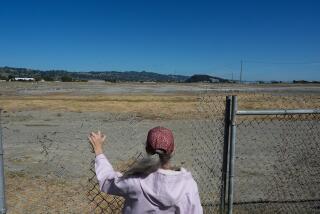Duke Energy accused of mishandling more coal ash wastewater
MONCURE, N.C. - While poring over regulatory documents for Duke Energy coal ash ponds, environmentalists at the Waterkeeper Alliance grew suspicious of the way the giant utility was handling the toxic ash waste left over from burning coal.
They decided to send up a team in an aircraft to photograph Duke’s shuttered Cape Fear coal-burning power plant and ash ponds, tucked into piney woods in this tiny community in central North Carolina.
The photos revealed what the Waterkeeper Alliance says is evidence that Duke, the nation’s largest electric utility, is deliberately pumping toxic coal ash wastewater from the containment ponds into a canal that eventually feeds into the Cape Fear River, a source of drinking water for downstream cities.
In the photos, two portable pumps and hoses can be seen drawing water from a coal ash pond and dumping into the canal and into nearby woods. According to the environmental group, that is a criminal violation of the Clean Water Act and state laws.
“They were trying to hide it. It was just dumb luck that we caught them at it,” said Peter Harrison, staff attorney for the alliance.
State regulators said the pumping could be illegal, and added that they were investigating the incident.
The allegations came as Duke and state regulators are under intense public and political pressure following the massive Feb. 2 Duke Energy coal ash spill that coated the Dan River with toxic coal ash sludge for at least 70 miles in North Carolina and Virginia. Hazardous heavy metals such as arsenic and lead were dumped into the river.
That spill, at a retired Duke Energy coal-fired plant in Eden, N.C., has led to allegations by environmental groups that state regulators have been soft on Duke and have ignored coal ash seepage for years from 14 Duke plants in North Carolina. It was the third-worst spill in U.S. history.
Federal prosecutors have announced a criminal investigation into the relationship between the state agency and Duke Energy. They have said they are seeking evidence of any money or gifts exchanging hands.
Officials at the state agency and at Duke Power have been issued subpoenas to appear before a grand jury this week.
In a statement, Duke Energy said the pumps were permitted by state regulators.
“The pumps in question are temporary installations used to lower the water level in those ash basins in order to perform maintenance on equipment in the basins,” the statement said. “This maintenance activity is allowed under our permits and the N.C. Department of Environment and Natural Resources is aware that this work is occurring.”
A spokesman for the state agency, Drew Elliott, said in an email message: “Our inspectors noticed this pumping during an on-site inspection this week, and we are investigating the utility’s actions. While routine maintenance is allowed under the permit, discharge of untreated wastewater could be a violation.”
Elliott said he didn’t know whether the inspectors noticed the pumps before or after the Waterkeeper Alliance took aerial photos. The agency announced March 5 that, in its continuing response to the Dan River spill, it would conduct detailed inspections of all coal ash ponds at Duke’s 14 plants, including the Moncure plant.
Harrison called Duke Energy’s explanation “absurd.” He said no state permit would allow a utility to pump coal ash water from ponds because pumping would dredge up toxic heavy metals that settle at the bottom of the ponds.
State permits allow the utility to use vertical pipes to drain water from the top ponds when they fill up due to heavy rains or runoff, Harrison said. The idea is for the water to drain off when the level rises to the top of the pipe.
Harrison noted that one pump was gone and the other was no longer hooked up to pipes the day after the Waterkeeper Alliance took the photos.
On a followup boat visit on the canal near the ponds, Harrison and other members of the group were confronted by Duke Energy security officials who summoned a county deputy sheriff. The deputy ordered the team to stay off the canal near the shuttered power plant, according to a video aired by the Waterkeeper Alliance.
“It wasn’t anything that any permit would allow,” Harrison said of the pumping. “It was secretive. They were trying to get away with it.”
Donna Lisenby, a Waterkeeper member who has studied regulation of Duke’s coal ash ponds, called the utility’s explanation for the pumps “a rather lame attempt to escape possible criminal prosecution.”
Lisenby added: “I believe Duke may have intentionally pumped out coal ash water from the Cape Fear ash ponds in order to avoid the costs of treating the water and because they did not want to obtain a proper permit.”
The group also took photos of what Harrison said was seepage of coal ash sludge into the canal at several locations, all from ponds at the Duke Energy plant, he said. Harrison said the Waterkeeper team took samples of the sludge and expects laboratory test results this week.
Earlier this month, Duke Energy announced that it planned to move coal ash from several sites to dry, lined landfills away from bodies of water. Duke also said it planned to guard against another massive spill by eventually “accelerating the removal of water from the ash ponds” at its shuttered plants, including those on the Dan River and in Moncure.
Follow LATimes National on Facebook
ALSO:
Epic selfie after US Airways jet crashes in Philadelphia
Citing exclusion of gays, Boston mayor skips St. Patrick’s parade
Sinclair to plead guilty to lesser charges in Army sexual abuse case
Twitter: @davidzucchino
More to Read
Sign up for Essential California
The most important California stories and recommendations in your inbox every morning.
You may occasionally receive promotional content from the Los Angeles Times.











